These instructions are for Cisco UCS B200 M2 blade server firmware upgrade from 2.0(1q) to 2.0(3a) (Vblock support matrix 2.5.9).
- Before you start downloading firmware and upgrading UCS Manager and the blades, it may be a good idea to go through some housekeeping:
- Login to UCS Manager. Verify overall status of Fabric Interconnects, I/O Modules, Servers and Adapters;
- Navigate to Admin tab, Faults, Events and Audit Log. Make sure there are no alerts or if they can be safely ignored;
- Equipment tab, Fabric Interconnects, Fabric Interconnect A/B. Make sure you have enough space on bootflash;

- Backup your current configuration. Admin tab, All node, select Backup Configuration, Create Backup Operation. Make sure you specify the file name and extension, Click OK
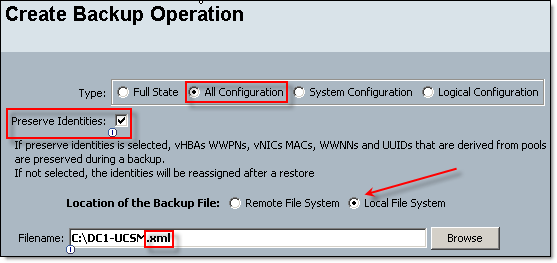
- Download firmware upgrade bundles from Cisco website
Downloads Home > Products > Unified Computing and Servers > Cisco UCS Infrastructure and UCS Manager Software:- UCS Infrastructure bundle – ucs-k9-bundle-infra.2.0.3a.A.bin
- UCS B-Series blade server products bundle – ucs-k9-bundle-b-series.2.0.3a.B.bin
- If you have any C-Series servers managed by UCS Manager then also download Software for the UCS C-Series rack-mount servers. ucs-k9-bundle-c-series.2.0.3a.C.bin

- Upload firmware upgrade bundles to Fabric Interconnects.
If you have two Fabric Interconnects configured as a cluster, the firmware upgrade bundles will be uploaded to both FIs. It does not matter which FI, primary or subordinate, you are connected to. Even if one FI is down, you still can upload firmware upgrades to the active FI. Software and configuration will be re-synced when FI comes back online.- Equipment tab, Equipment node, in the work pane select Installed Firmware, Download Firmware, Browse to the files you downloaded from Cisco in step 2 and upload firmware upgrade bundles to Fabric Interconnects. If you run out of space, delete old/unused software bundles. Click on Packages tab and confirm software bundles have been uploaded
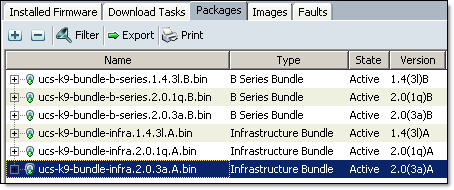
- UCS B-Series blade server products bundle (ucs-k9-bundle-b-series.2.0.3a.B.bin) contains server BIOS, CIMC and adapter firmware upgrades. In the final step (4.12) we will be upgrading server BIOS and therefore need to know what version is included in the software bundle we have just uploaded. In this example I will be upgrading Cisco UCS B200 M2 server BIOS. The BIOS version is S5500.2.0.3.0.050720121819.bin
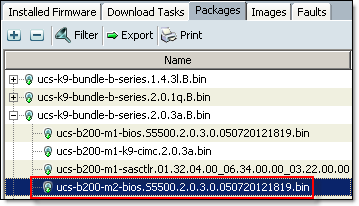
- Equipment tab, Equipment node, in the work pane select Installed Firmware, Download Firmware, Browse to the files you downloaded from Cisco in step 2 and upload firmware upgrade bundles to Fabric Interconnects. If you run out of space, delete old/unused software bundles. Click on Packages tab and confirm software bundles have been uploaded
- Follow these steps to upgrade UCS Manager, Fabric Interconnects, I/O Modules, server BIOS, CIMC, Adapters and Controllers:
Some of these steps take long time to complete. Please don’t panic, let UCS Manager do its job!!!- Disable Call Home.
Navigate to Admin tab, All node, Communication Management, Call Home. In the work pane change State to Off, click on Save Changes; - Update Adapters, CIMC and I/O Modules.
When you update firmware is just loads new version to Backup Version slot. The new version will be activated when you restart components.
Navigate to Equipment, Equipment node. In the Work pane click Firmware Management, Installed Firmware. Select specific Servers / Chassis you would like update components on or select UCS Manager to update components in all servers managed by this UCS Manager- Update Adapter firmware:
Click Update Firmware, Select Adapters from the Filter: drop-down menu, Select (o) Bundle, Set Bundle to the version you want to upgrade to and click OK.
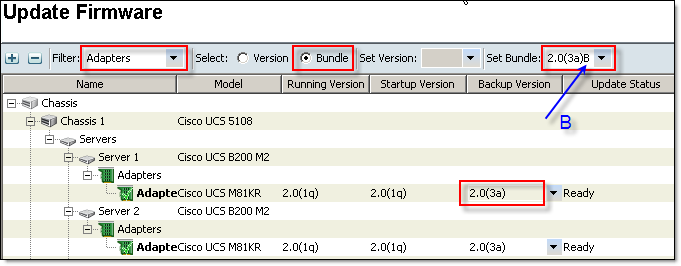
- Update CIMC:
Click Update Firmware, Select CIMC Controller from the Filter: drop-down menu, Select (o) Bundle, Set Bundle to the version you want to upgrade to and click OK.

- Update I/O Modules
Click Update Firmware, Select IO Modules from the Filter: drop-down menu, Select (o) Bundle, Set Bundle to the version you want to upgrade to and click OK.

- Update Adapter firmware:
- Activate adapters — Choose Ignore Compatibility Check and Set Startup Version Only when performing this step
Click Activate Firmware, Select Adapters from the Filter: drop-down menu, Select (o) Bundle, Set Bundle to the version you want to upgrade to and click OK.

Activation Status will change to Pending Next Boot - Activate CIMC — Choose Ignore Compatibility Check when performing this step
Click Activate Firmware, Select CIMC Controller from the Filter: drop-down menu, Select (o) Bundle, Set Bundle to the version you want to upgrade to and click OK.
CIMC firmware will be upgraded, CIMC controllers restarted, all active CIMC sessions will be disconnected.

- Activate Cisco UCS Manager — Choose Ignore Compatibility Check when performing this step
Click Activate Firmware, Select UCS Manager from the Filter: drop-down menu, Select (o) Bundle, Set Bundle to the version you want to upgrade to, select ICC and click OK.
Confirm to ignore compatibility check.

You will loose connection to UCS Manager. Please log back in. - Activate I/O modules — Choose Ignore Compatibility Check and Set Startup Version Only when performing this step

Activation Status will change to Pending Next Boot - Activate subordinate fabric interconnect — Choose Ignore Compatibility Check when performing this step.
All I/O Modules in the data path of this Fabric Interconnect will be restarted and firmware upgraded (see step 6). You need to make sure your blades are configured for data path redundancy, otherwise you will experience downtime on blades.

Fabric Interconnect firmware upgrade is quite long process, be patient. Wait for Fabric Interconnect to get back online and make sure that it is Ready and Status is Up:

- Manually failover the primary fabric interconnect to the fabric interconnect that has already been upgraded
DC1-FIC01-A# show cluster state Cluster Id: 0xbf9b6f54f8c411e0-0x9dac547fee135684 A: UP, PRIMARY B: UP, SUBORDINATE HA READY DC1-FIC01-A# connect local-mgmt Cisco Nexus Operating System (NX-OS) Software (--+-- Skipped --+--) DC1-FIC01-A(local-mgmt)# cluster lead b Cluster Id: 0xbf9b6f54f8c411e0-0x9dac547fee135684 DC1-FIC01-A(local-mgmt)#
You will loose connection to UCS Manager, Log back in again
- Verify that the data path has been restored
- Activate primary fabric interconnect — Choose Ignore Compatibility Check when performing this step.
All I/O Modules in the data path of this Fabric Interconnect will be restarted and firmware upgraded (see step 6). You need to make sure your blades are configured for data path redundancy, otherwise you will experience downtime on blades.

Fabric Interconnect firmware upgrade is quite long process, be patience. Wait for Fabric Interconnect to get back online and make sure that it is Ready and Status is Up:

- I like to keep Fabric Interconnect A as Primary.
DC1-FIC01-B# show cluster state Cluster Id: 0xbf9b6f54f8c411e0-0x9dac547fee135684 B: UP, PRIMARY A: UP, SUBORDINATE HA READY DC1-FIC01-B# connect local-mgmt Cisco Nexus Operating System (NX-OS) Software (--+-- Skipped --+--) DC1-FIC01-B(local-mgmt)# cluster lead a Cluster Id: 0xbf9b6f54f8c411e0-0x9dac547fee135684 DC1-FIC01-B(local-mgmt)#
Log back in again…
- Update host firmware package(s) for servers — Must be the last firmware upgraded.
Host firmware package will include firmware upgrade for BIOS, Storage Controller and Adapters. You can amend existing Host Firmware Package to include new firmware versions or create a new one. New Host firmware package will need to be associated with the Server Service Profile(s). Before you amend Host Profile Package to include new firmware or associate a new Host Profile Package with a Service Profile, make sure you check and understand how these changes will affect physical servers. Make sure you have management policy setup correctly. Open Servers tab, Policies node, Maintenance Policies.

Immediately – the server will be rebooted immediately after you amend Host Profile Package already associated with Service Profile;
User Ack – User will need to acknowledge server reboot in Pending Activities. The interesting part is that even if user reboots the server manually, the changes will not be activated, you need to acknowledge the changes in Pending Activities.
Timer Automatic– Automatic reboot during scheduled maintenance window(s)- Create a new Host Profile Package: Navigate to Servers tab, Policies, Host Profile Packages. Right click on Host Profile Packages, select Create Host Firmware Package
- Select BIOS version you made a note of in the step 3.2, click OK
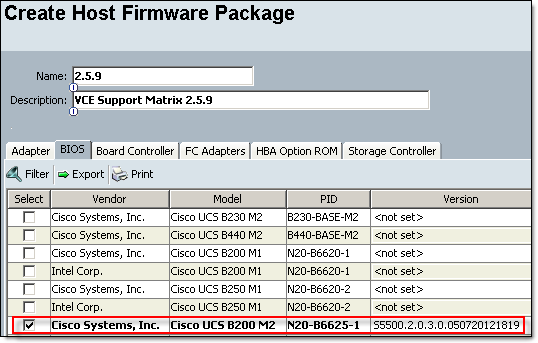
- Assign newly created Host Profile Package to a Service Profile: Navigate to Servers tab, Service Profiles, select Service Profile assigned to server(s) you would like to upgrade. In the Work pane click on Policies tab and expand Firmware Policies, select Host Profile Package and click Save Changes. Depending on the Maintenance Policy configured, the server will be rebooted immediately or you will need to acknowledge reboot when you ready.
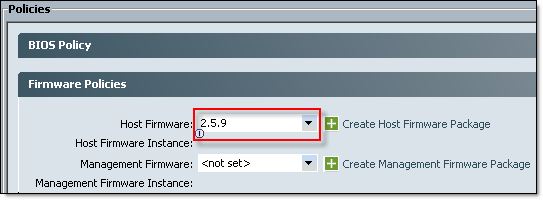
- Enable Call Home.
Navigate to Admin tab, All node, Communication Management, Call Home. In the work pane change State to On, click on Save Changes.
- Disable Call Home.
Hope this will help.

This info. was beautiful and well explained. Thanks a lot.
Thanks for your practices! :)
This is really really a nice url and well drafted.
[…] Modules and B-Series blade server firmware I know some of my readers look after UCS gear and so this article is for you. I love how it does a backup first! I did not know it could do […]
Great guide, thanks. Whats the difference between selecting Bundle over Version as I’ve always selected Version in the past and its updated as expected?
Thanks Rosco,

There is no difference, you can use either.
I think the only difference is with BIOS where the latest Bundle may not have newer version, like in the following screenshot:
Mark thanks for sharing this HOW TO!
It is well explained and it has been very helpful for me.
Regards
Awesome guide Mark!
Thanks you for sharing the detailed step by step guide for UCS firmware update. Really helpful.
really nice guide thanks !
[…] HOW TO: Upgrade Cisco UCS Manager, Fabric Interconnects, I/O Modules and B-Series blade server firmw…. These instructions are for Cisco UCS B200 M2 blade server firmware upgrade from 2.0(1q) to 2.0(3a) (Vblock support matrix 2.5.9). […]
[…] del upgrade del UCS Manager (Proceso del Upgrade) a la versión 2.2(6e), se tuvo el inconveniente de que el Vcenter no levantó. Se debió a que la […]
Thanks so much!
In my setup, FI A has updated firmware (latest version activated than FI-B) and FI B has older Firmware activated (But latest firmware is already upload in its flash/storage). If I configure & activate FI-B firmware equal to FI-A, will this process reboot FI-B ?
Please someone guide…Thanks